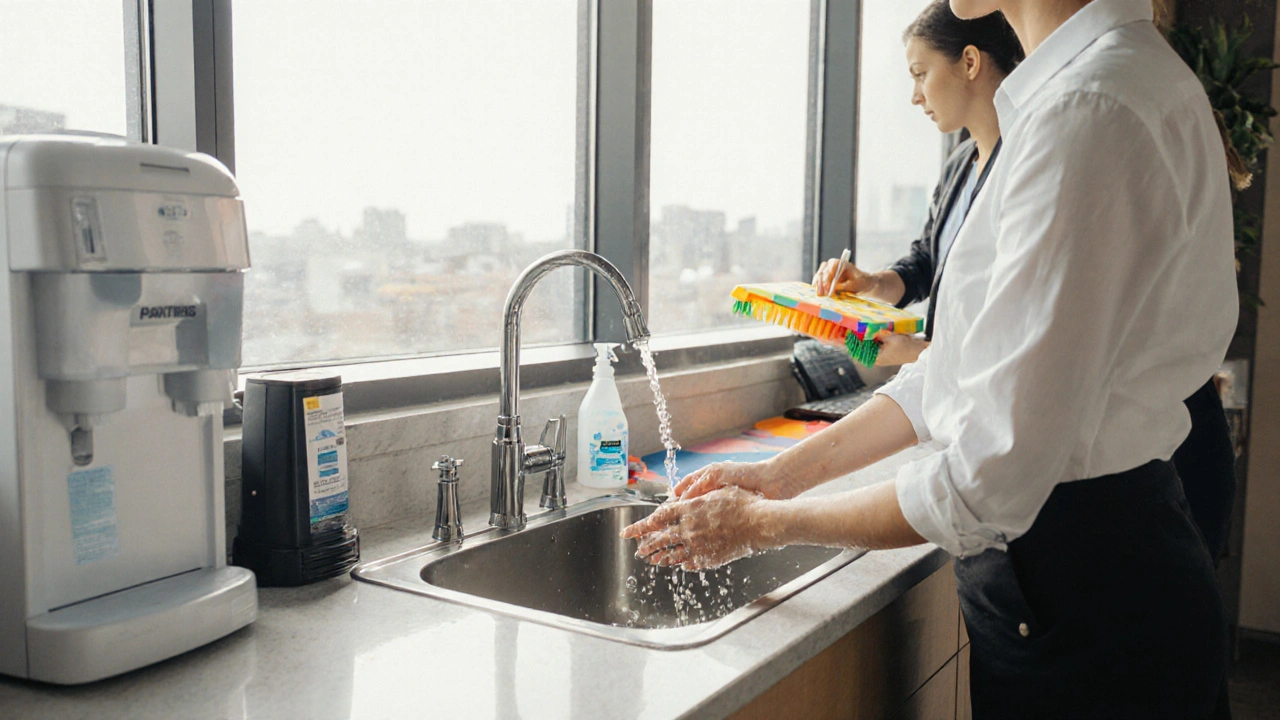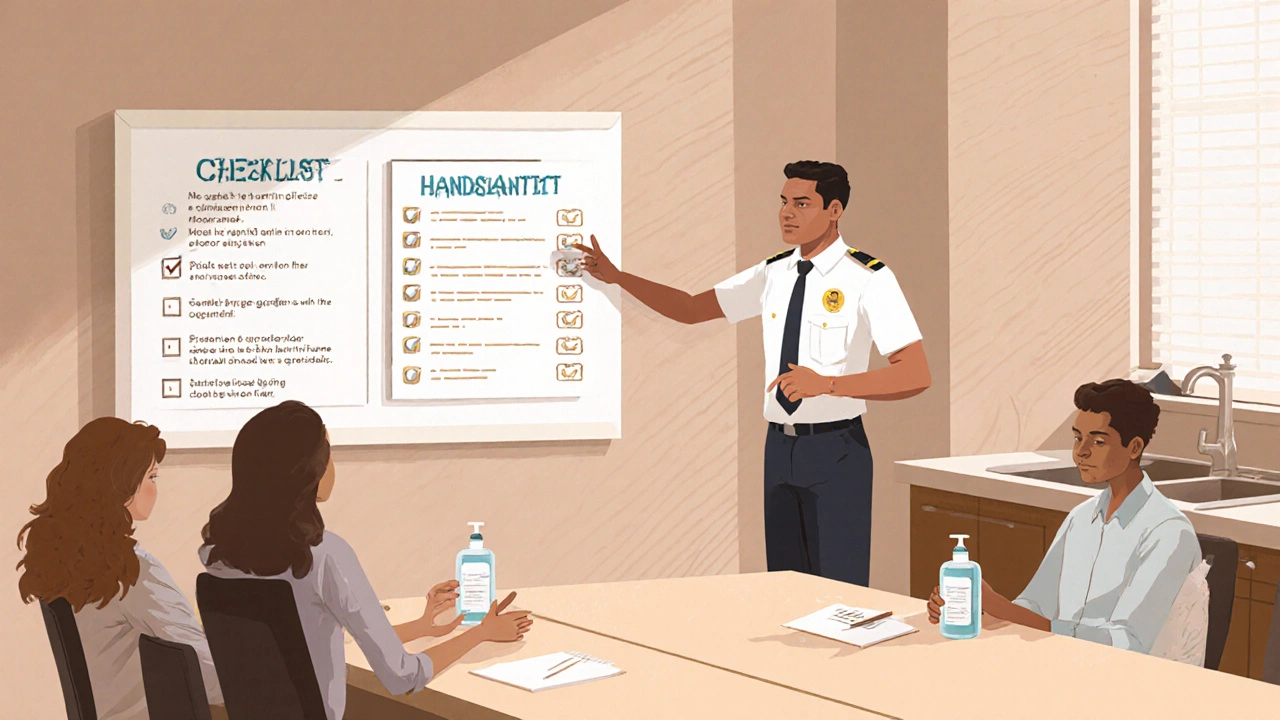Amebiasis Prevention Checklist
Recommended Preventive Actions
Amebiasis is a parasitic infection caused by the protozoan Entamoeba histolytica, usually spread through contaminated food or water. When the parasite slips into a busy office kitchen or a manufacturing break‑room, the consequences can go beyond a single sick employee. Understanding how the bug works and what hygiene habits actually stop it can save sick days, legal headaches, and reputational damage.
Quick Takeaways
- Amebiasis is transmitted via the fecal‑oral route, often through unsafe water or food.
- Common workplace sources: shared utensils, unclean surfaces, and inadequate hand‑washing.
- Key prevention steps: proper hand hygiene, safe food handling, and regular cleaning of high‑touch areas.
- If symptoms appear, isolate the employee, arrange stool testing, and follow CDC and OSHA guidelines.
- Documented policies protect both workers and employers from liability.
What Is Amebiasis?
The disease stems from ingesting cysts of Entamoeba histolytica. Once inside the gut, the cysts transform into trophozoites that can invade the intestinal lining, causing abdominal pain, diarrhea, and sometimes bloody stools. In severe cases the parasite breaches the colon and reaches the liver, leading to an abscess that requires hospitalization.
According to the Centers for Disease Control and Prevention (CDC), worldwide there are an estimated 50million cases annually, with millions of new infections each year. Though most cases occur in regions with poor sanitation, the parasite does not respect borders - it can thrive wherever food, water, and lapses in hygiene meet.
How Amebiasis Can Arrive at Work
Office cafeterias, factory mess halls, and construction site canteens are hotbeds for cross‑contamination. Here are the usual suspects:
- Contaminated water sources. A water cooler that isn’t regularly disinfected can become a reservoir for cysts.
- Improper food handling. Cutting boards or utensils that switch from raw vegetables to ready‑to‑eat snacks without thorough cleaning spread the parasite.
- Inadequate hand hygiene. Employees who skip hand‑washing after restroom breaks or before meals can unknowingly pass cysts to coworkers.
- Shared equipment. Kitchen sponges, dishcloths, and even non‑food tools like pens can carry cysts if not sanitized.
The Occupational Safety and Health Administration (OSHA) lists “fecal‑oral transmission” as a direct occupational hazard when sanitation standards lapse, especially in food‑service environments.

Core Hygiene Practices That Stop Transmission
Good hygiene is more than a checklist; it’s a behavior loop that needs reinforcement. Below are the proven actions backed by CDC research.
- Handwashing with soap. Scrub for at least 20 seconds, covering all surfaces. If soap isn’t available, use an alcohol‑based hand sanitizer containing at least 60% alcohol, but remember it’s less effective against cysts than soap and water.
- Safe water handling. Use filtered or boiled water for drinking and food preparation. Regularly disinfect water dispensers with a chlorine solution (1part bleach to 100parts water) and let them sit for 30minutes.
- Food safety protocols. Separate raw produce from ready‑to‑eat items, use color‑coded cutting boards, and sanitize surfaces with a hot‑water rinse followed by a sanitizer approved for food‑contact surfaces.
- Environmental cleaning. High‑touch surfaces (door handles, keyboards, phones) should be wiped down at least twice daily with EPA‑registered disinfectants that are effective against protozoan cysts.
- Personal protective equipment (PPE) where appropriate. In food‑service or laboratory settings, gloves can add a barrier, but they must be changed regularly and hands washed before putting them on.
When Symptoms Appear: A Step‑by‑Step Response
Early detection minimizes spread. Here’s what managers should do if an employee reports diarrhea, stomach cramps, or blood in stool:
- Isolate the employee. Encourage them to work from home or take sick leave until a diagnosis is confirmed.
- Arrange diagnostic testing. Stool testing for Entamoeba histolytica is the gold standard. Many occupational health clinics offer rapid PCR panels.
- Notify health authorities. Report the case to local public‑health departments if multiple employees become ill; this may trigger an outbreak investigation.
- Deep clean the affected area. Follow CDC’s Guidelines for Environmental Cleaning in Outbreak Settings - this includes disposing of contaminated food, disinfecting surfaces, and changing any reusable kitchen linens.
- Educate staff. Send a brief memo reminding everyone of proper hand hygiene and safe food practices, without singling out the sick employee.
Legal and Policy Considerations
Employers run the risk of violating the Occupational Safety and Health Act if they ignore a clear hazard. OSHA recommends a written Infection Control Plan that covers:
- Routine sanitation schedules.
- Training modules on hand hygiene and food safety.
- Procedures for reporting and responding to gastrointestinal illnesses.
Additionally, the Americans with Disabilities Act (ADA) requires reasonable accommodations for employees undergoing treatment, which may include flexible scheduling for medical appointments.
Quick Checklist for Managers
| Action | Frequency | Responsible Party |
|---|---|---|
| Inspect water dispensers for cleanliness | Weekly | Facilities Manager |
| Replace kitchen sponges and cloths | Every 3 days | Office Administrator |
| Conduct hand‑washing demo | Monthly | Health & Safety Officer |
| Review employee sick‑leave reports for GI symptoms | Continuously | HR Department |
| Update infection‑control policy | Annually or after an incident | Legal/Compliance Team |

Frequently Asked Questions
Can amebiasis be caught from a coworker’s hand?
Yes. If an infected person fails to wash their hands after using the restroom and then touches shared surfaces or food, the cysts can transfer to another person who later ingests them.
Is alcohol‑based hand sanitizer enough to kill the parasite?
Hand sanitizer reduces many germs but is less reliable against hardy cysts. Soap and water remain the gold standard for removing Entamoeba histolytica cysts.
What should I do if a food‑service employee reports bloody diarrhea?
Treat it as a potential outbreak. Have the employee stop handling food immediately, arrange stool testing, and deep‑clean all kitchen equipment. Notify local health authorities if more cases appear.
Are there any vaccines available for amebiasis?
No licensed vaccine exists yet. Prevention relies entirely on sanitation, safe water, and proper hygiene practices.
How long can cysts survive on surfaces?
Cysts can remain viable for weeks in moist environments. Regular disinfection with EPA‑approved products shortens their lifespan dramatically.
